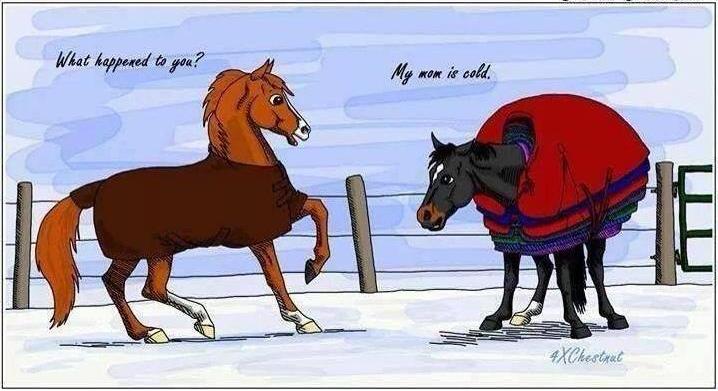Clothing for the Long Distance Rider
Clothing for the Long Distance Rider
by Anne Mackay
Suitable clothing for the long distance rider is almost as important as proper fitting tack for the horse! Hopefully the following tips will help you to ride many miles, protected from the elements and as comfortable in your clothing at the end of a long ride as you were at the beginning.
Lets work from innerwear to outerwear, starting with underwear. Preferably underwear should be cotton, which minimizes heat buildup. Seam finishes should be as flat as possible - avoid double folds! Try to get underwear without a center back seam as over many miles, seams can cause irritation (i.e. blisters - we don't want them!). Seamless riding underwear is now available and is excellent. For women, I recommend a sports bra and one that is suitable for inner and outerwear incase the weather is so warm that you want to ride without a shirt.
For both men and women, suitable riding pants are essential. Snug fitting riding tights are probably the ultimate. Many people prefer tights with stirrups to ensure the tights can't slip up your leg. If wearing breeches, jeans or other pants, consider wearing nylons, tights or longjohns underneath the pant to minimize chafing. Avoid jeans with a double seam on the inside of the leg. Whatever pant you chose, try to make sure it doesn't twist, turn or ride up your leg.
Most experienced long distance riders bypass cowboy boots and English field boots for riding/running shoes or short lace up boots. This is because many endurance riders walk/run downhill, unlike CTR and JP riders who can't make forward progress unless mounted. Riding/running shoes are great as they have a heel to prevent your foot from sliding to far into the stirrup. If using regular running shoes, make sure the tread allows you to slip quickly out of the stirrup. It's important to have footwear that's suitable for long distance walking in case your horse is ever injured and you have to walk a long way to the next vet check or back to base camp.
In warm weather, I recommend wearing a loose cotton shirt to provide protection from the sun, branches and insects. If it is really hot out, open up your shirt and let the breeze blow through to cool you down. For major cooling effect, wet your shirt at vet checks and enjoy. If your cotton shirt doesn't have enough pockets, just sew on another one or two - great for carrying PR cards and maps. ( A great place to get cotton shirts is your local thrift store.) If you are the T-shirt type, go for 100% cotton and stay away from polyester blends which can be extremely hot when temperatures climb.
Lower leg protection is often needed, especially when riding in an English saddle. Quite a few people are bothered by the stirrup leathers or find their skin becomes irritated when in contact with horse sweat.
Headgear is essential for use during emergency landings and for protection from the sun and overhanging tree limbs. Hopefully all riders are using approved helmets. Helmet covers can be added to keep branches out of vents. When riding along narrow trails with overhanging branches, it's wise to wear glasses - eye injuries are no fun. And of course when the sun is out, don't forget your 'shades.' On a hot day, to help you stay cool, dunk a scarf in cold water and tie it loosely around your neck.
Remember to wear or carry gloves. When grappling with a difficult barbed wire gate, gloves can be a lifesaver - not to mention the protection they offer if your horse is pulling on the reins or if the weather turns bad.
Nowadays, even in British Columbia there is concern about Lyme disease and you can dress to protect yourself. Wear pants that tuck into your boots and tuck your shirt in at the waist. Spray exposed skin and clothing with Deet.
Whatever the weather, dress in layers, so that you can easily add or remove clothing as the weather changes. Try to choose shirts and jackets which button or zip up - clothing that has to be pulled on and off over the head can be awkward when riding, especially when wearing a helmet. If choosing a zippered garment, go for a 2 way zipper and always try to have clothing with as many pockets as possible, for stashing all your valuables. A dual purpose windbreaker/waterproof jacket or coat is a necessity, Goretex fabric jackets or Goretex clones are lightweight and easy to pack on a saddle. I find Aussie oilskins a bit too heavy for a long ride, although they are great for a short ride. Patterns for Aussie coats are now available and are just great made up in Goretex.
For cooler weather, polar fleece is great for layering and has a rain resistant property which helps keep you dry. Windproof polar fleece jackets and vests are available as are polar fleece tights for cold weather riding. Polar fleece ear muffs which strap onto riding helmets are ideal items for really cold weather riding.
So it's finally competition day and you're ready for the first 25, 50 or 100 mile ride. Dress for comfort and safety and only use 'tried and true' clothing. Never use new equipment on you or your horse on the day of a ride. Remember to pack your lip balm, sunscreen and mosquito repellent. Then you, the human half of the team, are ready for the ride.
Article is from "Going the Distance, Winter 1998" The newsletter of the Canadian Long Distance Riding Association

- Log in to post comments
